Optical Flow-Based Full-Field Quantitative Blood-Flow Velocimetry Using Temporal Direction Filtering and Peak Interpolation
Abstract
1. Introduction
2. Results
2.1. In-Vitro Phantom Experiment of RBC Flow in Glass Capillaries
2.2. In Vivo Blood-Flow Estimation
2.3. Comparative Experiments with Correlation PIV
3. Discussion
4. Materials and Methods
4.1. Optical Imaging System
4.2. Temporal Direction Filtering and Peak Interpolation Optical Flow
4.3. In Vitro Experiment
4.4. In Vivo Experiments
4.5. Comparative Experiments with Correlation PIV
4.6. Spacetime Image Velocimetry
5. Conclusions
Author Contributions
Funding
Institutional Review Board Statement
Informed Consent Statement
Data Availability Statement
Conflicts of Interest
References
- Zhao, B.; Li, T.; Fan, Z.; Yang, Y.; Shu, J.; Yang, X.; Wang, X.; Luo, T.; Tang, J.; Xiong, D.; et al. Heart-Brain Connections: Phenotypic and Genetic Insights from Magnetic Resonance Images. Science 2023, 380, abn6598. [Google Scholar] [CrossRef] [PubMed]
- Chojdak-Łukasiewicz, J.; Dziadkowiak, E.; Zimny, A.; Paradowski, B. Cerebral Small Vessel Disease: A Review. Adv. Clin. Exp. Med. 2021, 30, 349–356. [Google Scholar] [CrossRef]
- Hall, C.N.; Reynell, C.; Gesslein, B.; Hamilton, N.B.; Mishra, A.; Sutherland, B.A.; O’Farrell, F.M.; Buchan, A.M.; Lauritzen, M.; Attwell, D. Capillary Pericytes Regulate Cerebral Blood Flow in Health and Disease. Nature 2014, 508, 55–60. [Google Scholar] [CrossRef] [PubMed]
- Bonner, R.; Nossal, R. Model for Laser Doppler Measurements of Blood Flow in Tissue. Appl. Opt. 1981, 20, 2097. [Google Scholar] [CrossRef]
- Shi, L.; Qin, J.; Reif, R.; Wang, R.K. Wide Velocity Range Doppler Optical Microangiography Using Optimized Step-Scanning Protocol with Phase Variance Mask. J. Biomed. Opt. 2013, 18, 106015. [Google Scholar] [CrossRef][Green Version]
- Leitgeb, R.A.; Werkmeister, R.M.; Blatter, C.; Schmetterer, L. Doppler Optical Coherence Tomography. Prog. Retin. Eye Res. 2014, 41, 26–43. [Google Scholar] [CrossRef] [PubMed]
- Leitgeb, R.A.; Schmetterer, L.; Hitzenberger, C.K.; Fercher, A.F.; Berisha, F.; Wojtkowski, M.; Bajraszewski, T. Real-Time Measurement of in Vitro Flow by Fourier-Domain Color Doppler Optical Coherence Tomography. Opt. Lett. 2004, 29, 171. [Google Scholar] [CrossRef]
- Bonesi, M.; Churmakov, D.; Meglinski, I. Study of Flow Dynamics in Complex Vessels Using Doppler Optical Coherence Tomography. Meas. Sci. Technol. 2007, 18, 3279–3286. [Google Scholar] [CrossRef]
- Li, P.; Ni, S.; Zhang, L.; Zeng, S.; Luo, Q. Imaging Cerebral Blood Flow through the Intact Rat Skull with Temporal Laser Speckle Imaging. Opt. Lett. 2006, 31, 1824. [Google Scholar] [CrossRef]
- Wang, Y.; Wen, D.; Chen, X.; Huang, Q.; Chen, M.; Lu, J.; Li, P. Improving the Estimation of Flow Speed for Laser Speckle Imaging with Single Exposure Time. Opt. Lett. 2017, 42, 57. [Google Scholar] [CrossRef]
- Fercher, A.F.; Briers, J.D. Flow Visualization by Means of Single-Exposure Speckle Photography. Opt. Commun. 1981, 37, 326–330. [Google Scholar] [CrossRef]
- Hong, J.; Zhu, X.; Lu, J.; Li, P. Quantitative Laser Speckle Auto-Inverse Covariance Imaging for Robust Estimation of Blood Flow. Opt. Lett. 2021, 46, 2505. [Google Scholar] [CrossRef] [PubMed]
- Hong, J.; Shi, L.; Zhu, X.; Lu, J.; Li, P. Laser Speckle Auto-Inverse Covariance Imaging for Mean-Invariant Estimation of Blood Flow. Opt. Lett. 2019, 44, 5812. [Google Scholar] [CrossRef]
- Liu, X.; Wei, J.; Meng, L.; Cheng, W.; Zhu, X.; Lu, J.; Li, P. Motion Correction of Laser Speckle Imaging of Blood Flow by Simultaneous Imaging of Tissue Structure and Non-Rigid Registration. Opt. Lasers Eng. 2021, 140, 106526. [Google Scholar] [CrossRef]
- Postnov, D.D.; Tang, J.; Erdener, S.E.; Kılıç, K.; Boas, D.A. Dynamic Light Scattering Imaging. Sci. Adv. 2020, 6, eabc4628. [Google Scholar] [CrossRef]
- Li, Z.; Ge, Q.; Feng, J.; Jia, K.; Zhao, J. Quantification of Blood Flow Index in Diffuse Correlation Spectroscopy Using Long Short-Term Memory Architecture. Biomed. Opt. Express 2021, 12, 4131. [Google Scholar] [CrossRef]
- Robinson, M.B.; Renna, M.; Ozana, N.; Martin, A.N.; Otic, N.; Carp, S.A.; Franceschini, M.A. Portable, High Speed Blood Flow Measurements Enabled by Long Wavelength, Interferometric Diffuse Correlation Spectroscopy (LW-IDCS). Sci. Rep. 2023, 13, 8803. [Google Scholar] [CrossRef]
- Kazmi, S.M.S.; Faraji, E.; Davis, M.A.; Huang, Y.-Y.; Zhang, X.J.; Dunn, A.K. Flux or Speed? Examining Speckle Contrast Imaging of Vascular Flows. Biomed. Opt. Express 2015, 6, 2588. [Google Scholar] [CrossRef]
- Duncan, D.D.; Kirkpatrick, S.J. Can Laser Speckle Flowmetry Be Made a Quantitative Tool? J. Opt. Soc. Am. A 2008, 25, 2088. [Google Scholar] [CrossRef]
- Raffel, M.; Willert, C.E.; Scarano, F.; Kähler, C.J.; Wereley, S.T.; Kompenhans, J. Particle Image Velocimetry: A Practical Guide; Springer International Publishing: Cham, Switzerland, 2018; ISBN 978-3-319-68851-0. [Google Scholar]
- Ha, H.; Nam, K.-H.; Lee, S.J. Hybrid PIV–PTV Technique for Measuring Blood Flow in Rat Mesenteric Vessels. Microvasc. Res. 2012, 84, 242–248. [Google Scholar] [CrossRef]
- Kurochkin, M.A.; Timoshina, P.A.; Fedosov, I.V.; Tuchin, V.V. Advanced Digital Methods for Blood Flow Flux Analysis Using MPIV Approach; Genina, E.A., Derbov, V.L., Larin, K.V., Postnov, D.E., Tuchin, V.V., Eds.; SPIE: Saratov, Russia, 2015; p. 94481A. [Google Scholar]
- Kamoun, W.S.; Chae, S.-S.; Lacorre, D.A.; Tyrrell, J.A.; Mitre, M.; Gillissen, M.A.; Fukumura, D.; Jain, R.K.; Munn, L.L. Simultaneous Measurement of RBC Velocity, Flux, Hematocrit and Shear Rate in Vascular Networks. Nat. Methods 2010, 7, 655–660. [Google Scholar] [CrossRef]
- Qureshi, M.M.; Liu, Y.; Mac, K.D.; Kim, M.; Safi, A.M.; Chung, E. Quantitative Blood Flow Estimation in Vivo by Optical Speckle Image Velocimetry. Optica 2021, 8, 1092. [Google Scholar] [CrossRef]
- Li, C.; Wang, R.K. Velocity Measurements of Heterogeneous RBC Flow in Capillary Vessels Using Dynamic Laser Speckle Signal. J. Biomed. Opt. 2017, 22, 046002. [Google Scholar] [CrossRef] [PubMed]
- Zeidan, A.; Yelin, D. Reflectance Confocal Microscopy of Red Blood Cells: Simulation and Experiment. Biomed. Opt. Express 2015, 6, 4335. [Google Scholar] [CrossRef]
- Choi, S.M.; Kim, W.H.; Côté, D.; Park, C.-W.; Lee, H. Blood Cell Assisted In Vivo Particle Image Velocimetry Using the Confocal Laser Scanning Microscope. Opt. Express 2011, 19, 4357. [Google Scholar] [CrossRef] [PubMed]
- Driscoll, J.D.; Shih, A.Y.; Drew, P.J.; Cauwenberghs, G.; Kleinfeld, D. Two-Photon Imaging of Blood Flow in the Rat Cortex. Cold Spring Harb. Protoc. 2013, 2013, 759–767. [Google Scholar] [CrossRef]
- Lindvere, L.; Dorr, A.; Stefanovic, B. Two-Photon Fluorescence Microscopy of Cerebral Hemodynamics. Cold Spring Harb. Protoc. 2010, 2010, pdb.prot5494. [Google Scholar] [CrossRef]
- Mazlin, V.; Xiao, P.; Scholler, J.; Irsch, K.; Grieve, K.; Fink, M.; Boccara, A.C. Real-Time Non-Contact Cellular Imaging and Angiography of Human Cornea and Limbus with Common-Path Full-Field/SD OCT. Nat. Commun. 2020, 11, 1868. [Google Scholar] [CrossRef]
- Kähler, C.J.; Scharnowski, S.; Cierpka, C. On the Resolution Limit of Digital Particle Image Velocimetry. Exp. Fluids 2012, 52, 1629–1639. [Google Scholar] [CrossRef]
- Kim, T.N.; Goodwill, P.W.; Chen, Y.; Conolly, S.M.; Schaffer, C.B.; Liepmann, D.; Wang, R.A. Line-Scanning Particle Image Velocimetry: An Optical Approach for Quantifying a Wide Range of Blood Flow Speeds in Live Animals. PLoS ONE 2012, 7, e38590. [Google Scholar] [CrossRef]
- Yang, Z.; Yu, H.; Huang, G.P.; Ludwig, B. Divergence Compensatory Optical Flow Method for Blood Velocimetry. J. Biomech. Eng. 2017, 139, 061005. [Google Scholar] [CrossRef]
- Lin, W.C.; Lin, T.J.; Tsai, C.L.; Lin, K.P. An Improved Method for Velocity Estimation of Red Blood Cell in Microcirculation. In Proceedings of the 2014 36th Annual International Conference of the IEEE Engineering in Medicine and Biology Society, Chicago, IL, USA, 26–30 August 2014; IEEE: Chicago, IL, USA, 2014; pp. 214–217. [Google Scholar]
- Wu, C.-C.; Zhang, G.; Huang, T.-C.; Lin, K.-P. Red Blood Cell Velocity Measurements of Complete Capillary in Finger Nail-Fold Using Optical Flow Estimation. Microvasc. Res. 2009, 78, 319–324. [Google Scholar] [CrossRef] [PubMed]
- Wu, T.-H.; Lin, C.-J.; Lin, Y.-H.; Guo, W.-Y.; Huang, T.-C. Quantitative Analysis of Digital Subtraction Angiography Using Optical Flow Method on Occlusive Cerebrovascular Disease. Comput. Methods Programs Biomed. 2013, 111, 693–700. [Google Scholar] [CrossRef] [PubMed]
- Wong, K.; Kuklik, P.; Kelso, R.M.; Worthley, S.G.; Sanders, P.; Mazumdar, J.; Abbott, D. Blood Flow Assessment in a Heart with Septal Defect Based on Optical Flow Analysis of Magnetic Resonance Images; Nicolau, D.V., Ed.; The International Society for Optical Engineering: Adelaide, Australia, 2006; p. 64160L. [Google Scholar]
- Kucukal, E.; Man, Y.; Gurkan, U.A.; Schmidt, B.E. Blood Flow Velocimetry in a Microchannel During Coagulation Using Particle Image Velocimetry and Wavelet-Based Optical Flow Velocimetry. J. Biomech. Eng. 2021, 143, 091004. [Google Scholar] [CrossRef] [PubMed]
- Zhong, Q.; Yang, H.; Yin, Z. An Optical Flow Algorithm Based on Gradient Constancy Assumption for PIV Image Processing. Meas. Sci. Technol. 2017, 28, 055208. [Google Scholar] [CrossRef]
- Ruhnau, P.; Kohlberger, T.; Schnorr, C.; Nobach, H. Variational Optical Flow Estimation for Particle Image Velocimetry. Exp. Fluids 2005, 38, 21–32. [Google Scholar] [CrossRef]
- Drew, P.J.; Blinder, P.; Cauwenberghs, G.; Shih, A.Y.; Kleinfeld, D. Rapid Determination of Particle Velocity from Space-Time Images Using the Radon Transform. J. Comput. Neurosci. 2010, 29, 5–11. [Google Scholar] [CrossRef]
- Chhatbar, P.Y.; Kara, P. Improved Blood Velocity Measurements with a Hybrid Image Filtering and Iterative Radon Transform Algorithm. Front. Neurosci. 2013, 7, 106. [Google Scholar] [CrossRef]
- Huang, T.-C.; Chang, C.-K.; Liao, C.-H.; Ho, Y.-J. Quantification of Blood Flow in Internal Cerebral Artery by Optical Flow Method on Digital Subtraction Angiography in Comparison with Time-Of-Flight Magnetic Resonance Angiography. PLoS ONE 2013, 8, e54678. [Google Scholar] [CrossRef]
- Guo, D.; van de Ven, A.L.; Zhou, X. Red Blood Cell Tracking Using Optical Flow Methods. IEEE J. Biomed. Health Inform. 2014, 18, 991–998. [Google Scholar] [CrossRef]
- Aminfar, A.; Davoodzadeh, N.; Aguilar, G.; Princevac, M. Application of Optical Flow Algorithms to Laser Speckle Imaging. Microvasc. Res. 2019, 122, 52–59. [Google Scholar] [CrossRef] [PubMed]
- Stanley, N.; Ciero, A.; Timms, W.; Hewlin, R.L. A 3-D Printed Optically Clear Rigid Diseased Carotid Bifurcation Arterial Mock Vessel Model for Particle Image Velocimetry Analysis in Pulsatile Flow. ASME Open J. Eng. 2023, 2, 021010. [Google Scholar] [CrossRef]
- Hewlin, R.L.; Kizito, J.P. Development of an Experimental and Digital Cardiovascular Arterial Model for Transient Hemodynamic and Postural Change Studies: “A Preliminary Framework Analysis”. Cardiovasc. Eng. Technol. 2018, 9, 1–31. [Google Scholar] [CrossRef] [PubMed]
- Nader, E.; Skinner, S.; Romana, M.; Fort, R.; Lemonne, N.; Guillot, N.; Gauthier, A.; Antoine-Jonville, S.; Renoux, C.; Hardy-Dessources, M.-D.; et al. Blood Rheology: Key Parameters, Impact on Blood Flow, Role in Sickle Cell Disease and Effects of Exercise. Front. Physiol. 2019, 10, 1329. [Google Scholar] [CrossRef] [PubMed]
- Roychoudhuri, C. Fundamentals of Photonics; SPIE: Bellingham, WA, USA, 2008; ISBN 978-0-8194-7128-4. [Google Scholar]
- Yao, J.; Gao, Y.; Yin, Y.; Lai, P.; Ye, S.; Zheng, W. Exploiting the Potential of Commercial Objectives to Extend the Field of View of Two-Photon Microscopy by Adaptive Optics. Opt. Lett. 2022, 47, 989. [Google Scholar] [CrossRef] [PubMed]
- Yang, W.; Yuste, R. In Vivo Imaging of Neural Activity. Nat. Methods 2017, 14, 349–359. [Google Scholar] [CrossRef] [PubMed]
- Ilg, E.; Mayer, N.; Saikia, T.; Keuper, M.; Dosovitskiy, A.; Brox, T. FlowNet 2.0: Evolution of Optical Flow Estimation with Deep Networks 2016. arXiv 2016. [Google Scholar] [CrossRef]
- Sun, H.; Dao, M.-Q.; Fremont, V. 3D-FlowNet: Event-Based Optical Flow Estimation with 3D Representation. In Proceedings of the 2022 IEEE Intelligent Vehicles Symposium (IV), Aachen, Germany, 5–9 June 2022; pp. 1845–1850. [Google Scholar]
- Yao, R.; Deng, H.; Zhang, W.; Chen, L.; An, F. Asynchronous Double-Frame-Exposure Binocular-Camera with Pixel-Level Pipeline Architecture for High-Speed Motion Tracking. IEEE Trans. Circuits Syst. II Express Briefs 2022, 69, 2967–2971. [Google Scholar] [CrossRef]
- Kang, L.; Yu, H.; Yang, X.; Zhu, Y.; Bai, X.; Wang, R.; Cao, Y.; Xu, H.; Luo, H.; Lu, L.; et al. Neutrophil Extracellular Traps Released by Neutrophils Impair Revascularization and Vascular Remodeling after Stroke. Nat. Commun. 2020, 11, 2488. [Google Scholar] [CrossRef]
- Pircher, J.; Czermak, T.; Ehrlich, A.; Eberle, C.; Gaitzsch, E.; Margraf, A.; Grommes, J.; Saha, P.; Titova, A.; Ishikawa-Ankerhold, H.; et al. Cathelicidins Prime Platelets to Mediate Arterial Thrombosis and Tissue Inflammation. Nat. Commun. 2018, 9, 1523. [Google Scholar] [CrossRef] [PubMed]
- Yu, Q.; Yang, X.; Zhang, C.; Zhang, X.; Wang, C.; Chen, L.; Liu, X.; Gu, Y.; He, X.; Hu, L.; et al. AMPK Activation by Ozone Therapy Inhibits Tissue Factor-triggered Intestinal Ischemia and Ameliorates Chemotherapeutic Enteritis. FASEB J. 2020, 34, 13005–13021. [Google Scholar] [CrossRef] [PubMed]
- Lu, L.; Bai, X.; Cao, Y.; Luo, H.; Yang, X.; Kang, L.; Shi, M.-J.; Fan, W.; Zhao, B.-Q. Growth Differentiation Factor 11 Promotes Neurovascular Recovery After Stroke in Mice. Front. Cell. Neurosci. 2018, 12, 205. [Google Scholar] [CrossRef]
- Zhao, R.; He, X.-W.; Shi, Y.-H.; Liu, Y.-S.; Liu, F.-D.; Hu, Y.; Zhuang, M.-T.; Feng, X.-Y.; Zhao, L.; Zhao, B.-Q.; et al. Cathepsin K Knockout Exacerbates Haemorrhagic Transformation Induced by Recombinant Tissue Plasminogen Activator After Focal Cerebral Ischaemia in Mice. Cell. Mol. Neurobiol. 2019, 39, 823–831. [Google Scholar] [CrossRef] [PubMed]
- Mestre, H.; Du, T.; Sweeney, A.M.; Liu, G.; Samson, A.J.; Peng, W.; Mortensen, K.N.; Stæger, F.F.; Bork, P.A.R.; Bashford, L.; et al. Cerebrospinal Fluid Influx Drives Acute Ischemic Tissue Swelling. Science 2020, 367, eaax7171. [Google Scholar] [CrossRef]
- Horn, B.; Schunck, B. Determining Optical Flow. In Proceedings of the Techniques and Applications of Image Understanding; Pearson, J.J., Ed.; SPIE: Bellingham, WA, USA, 1981; pp. 319–331. [Google Scholar] [CrossRef]
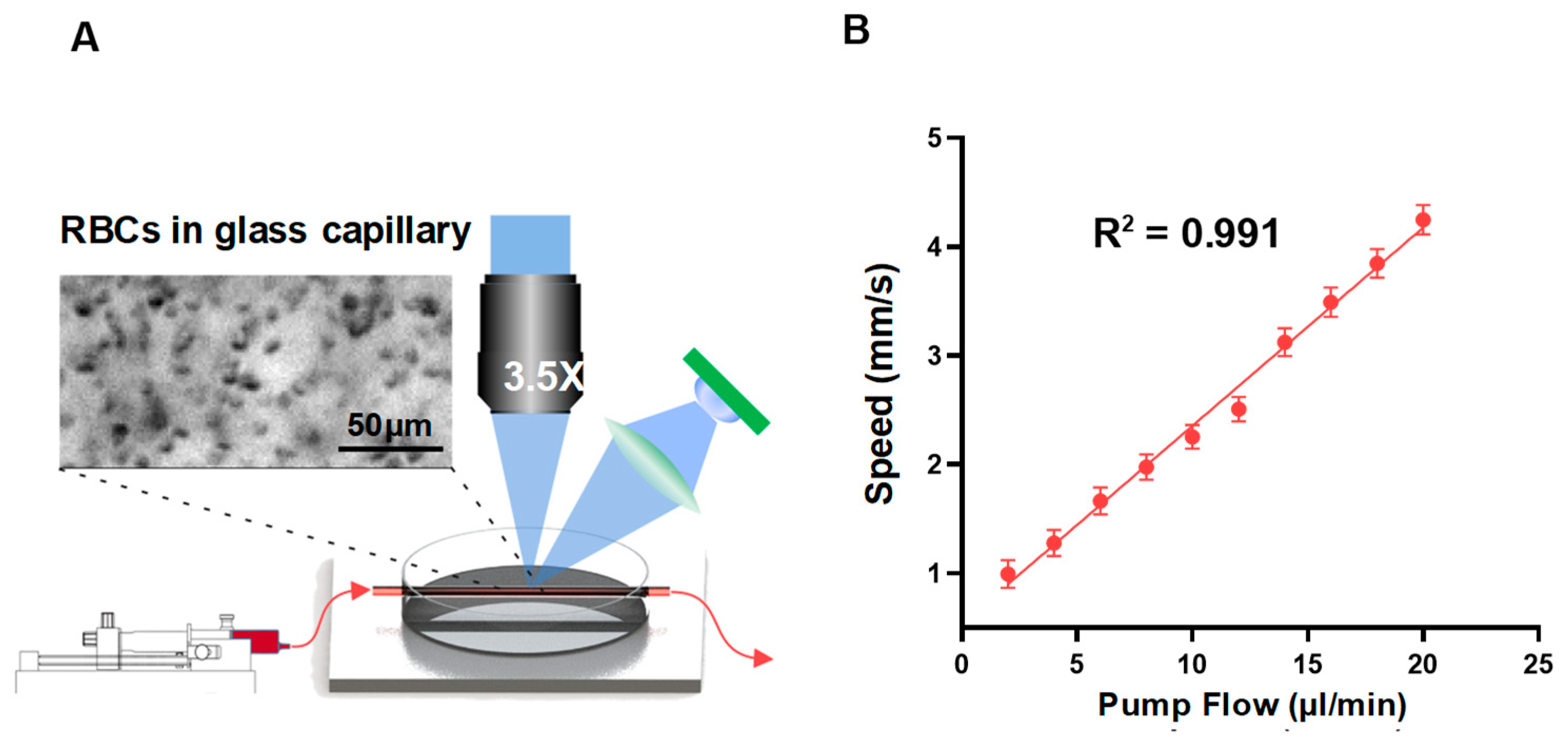
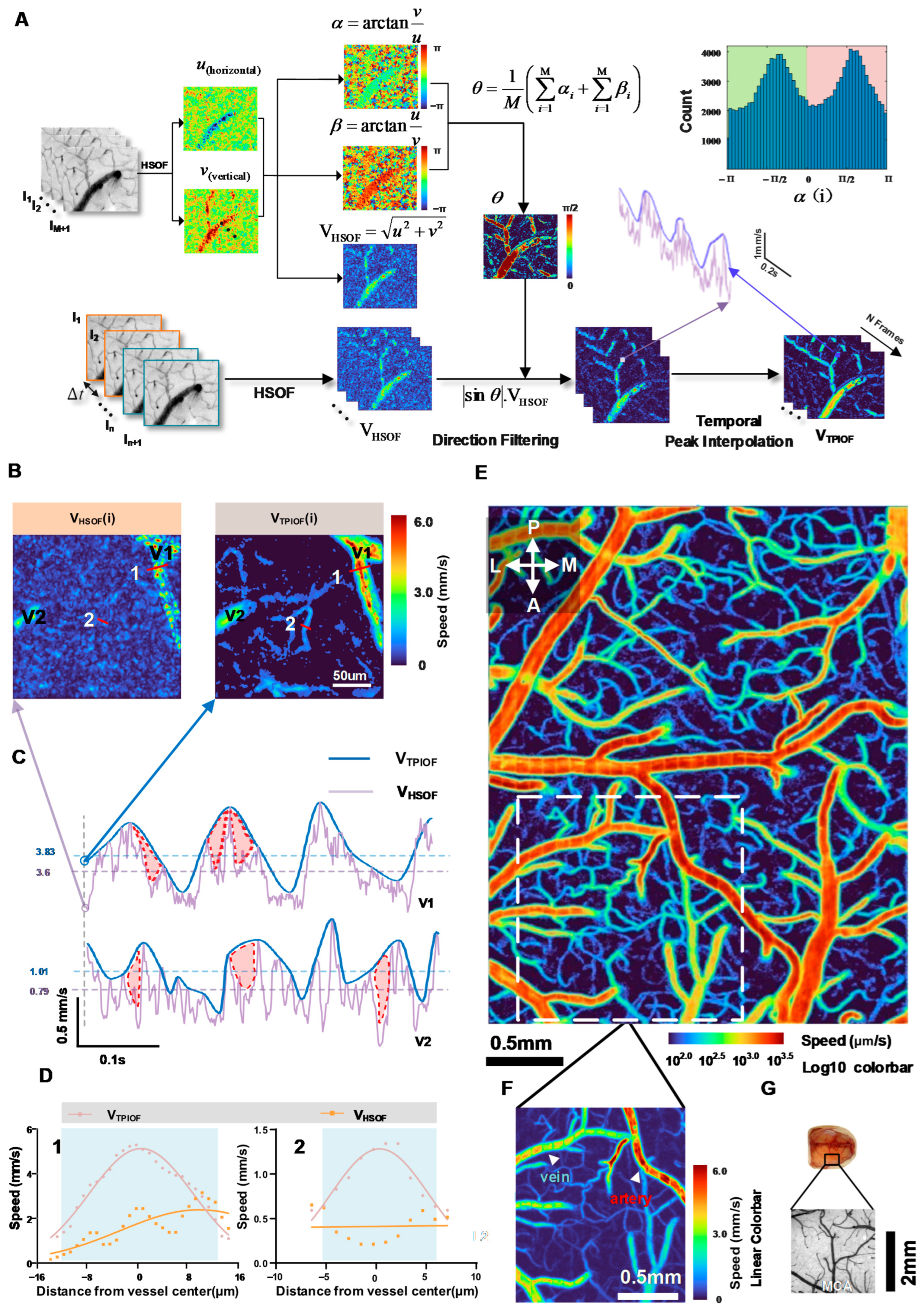
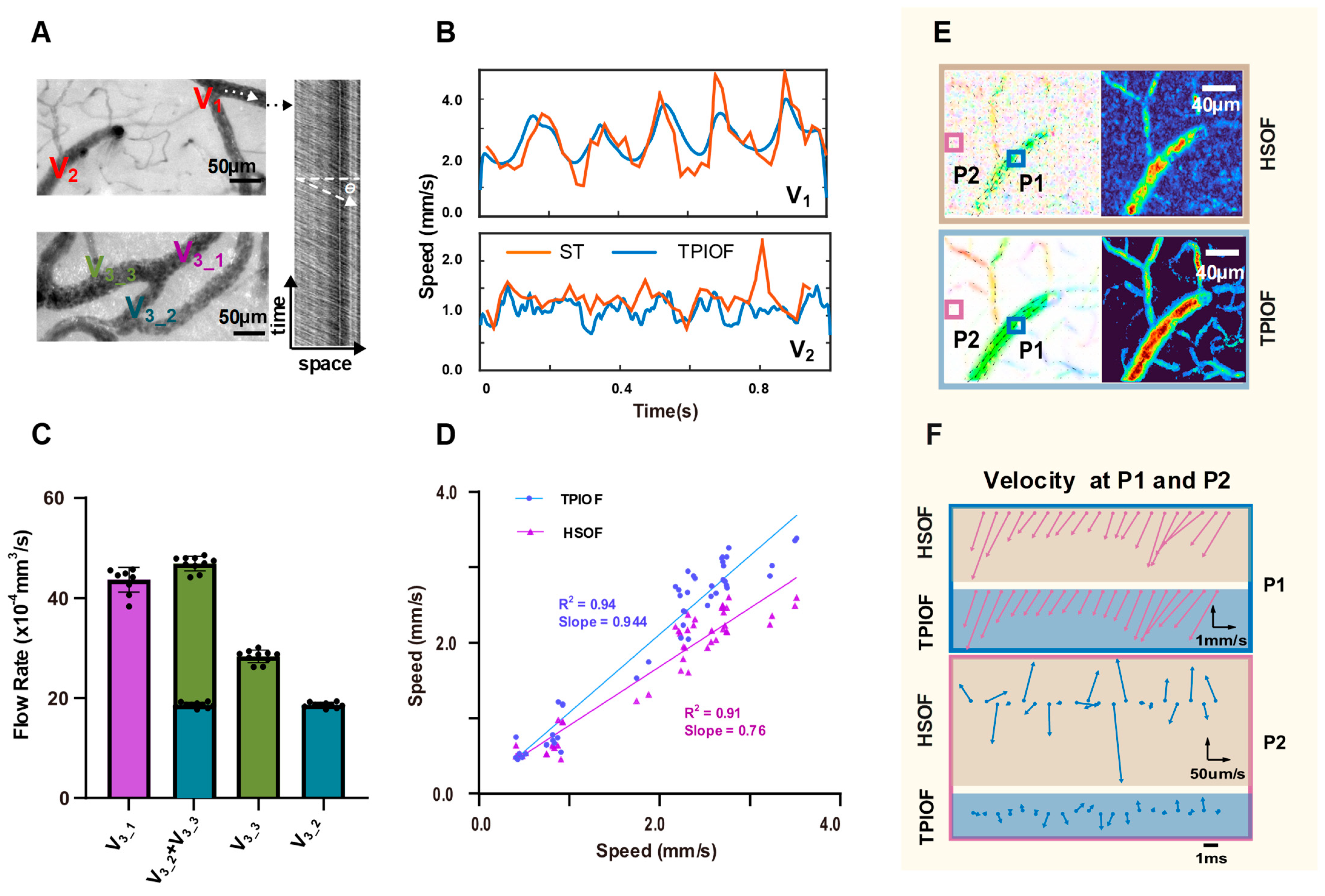
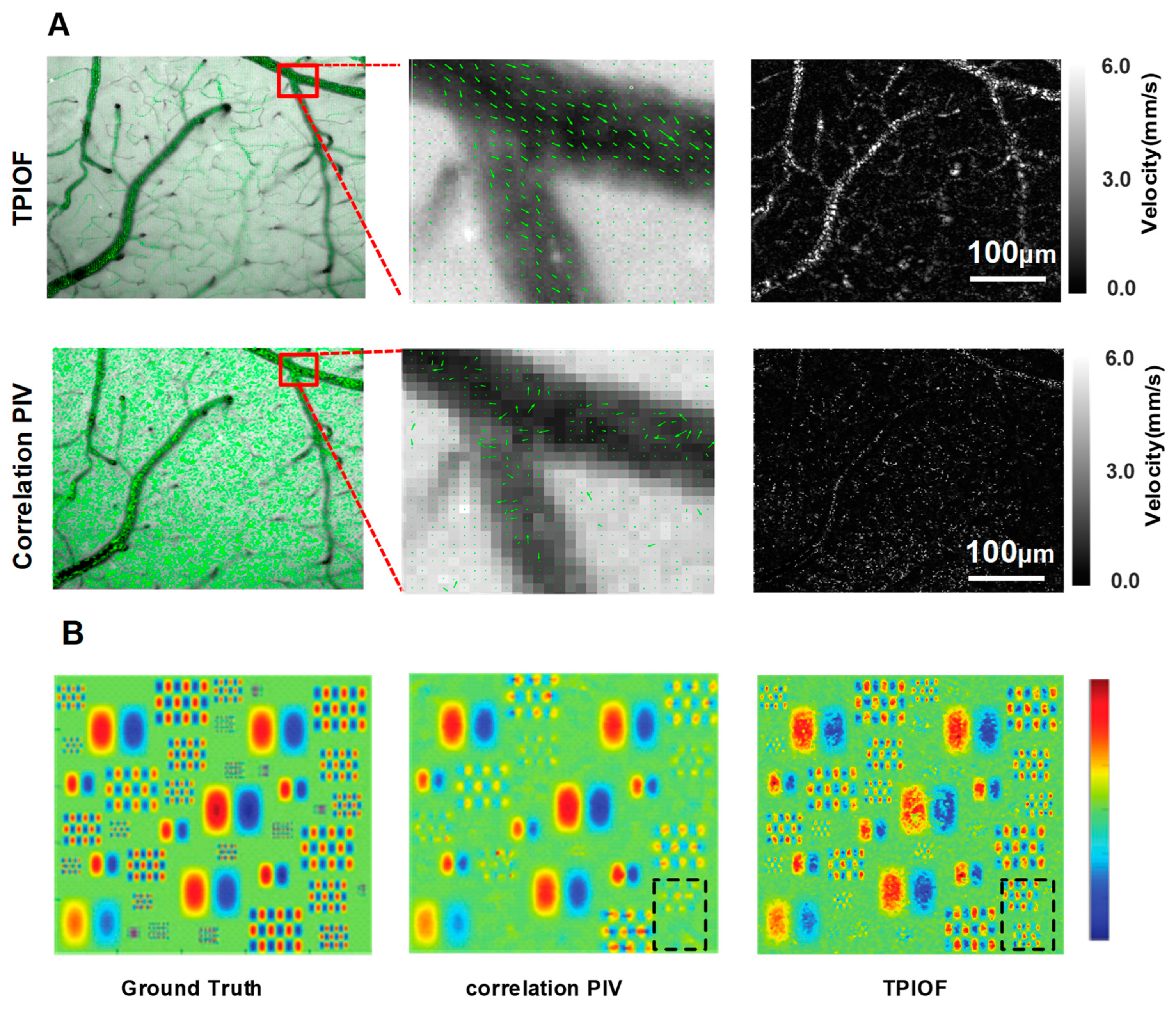
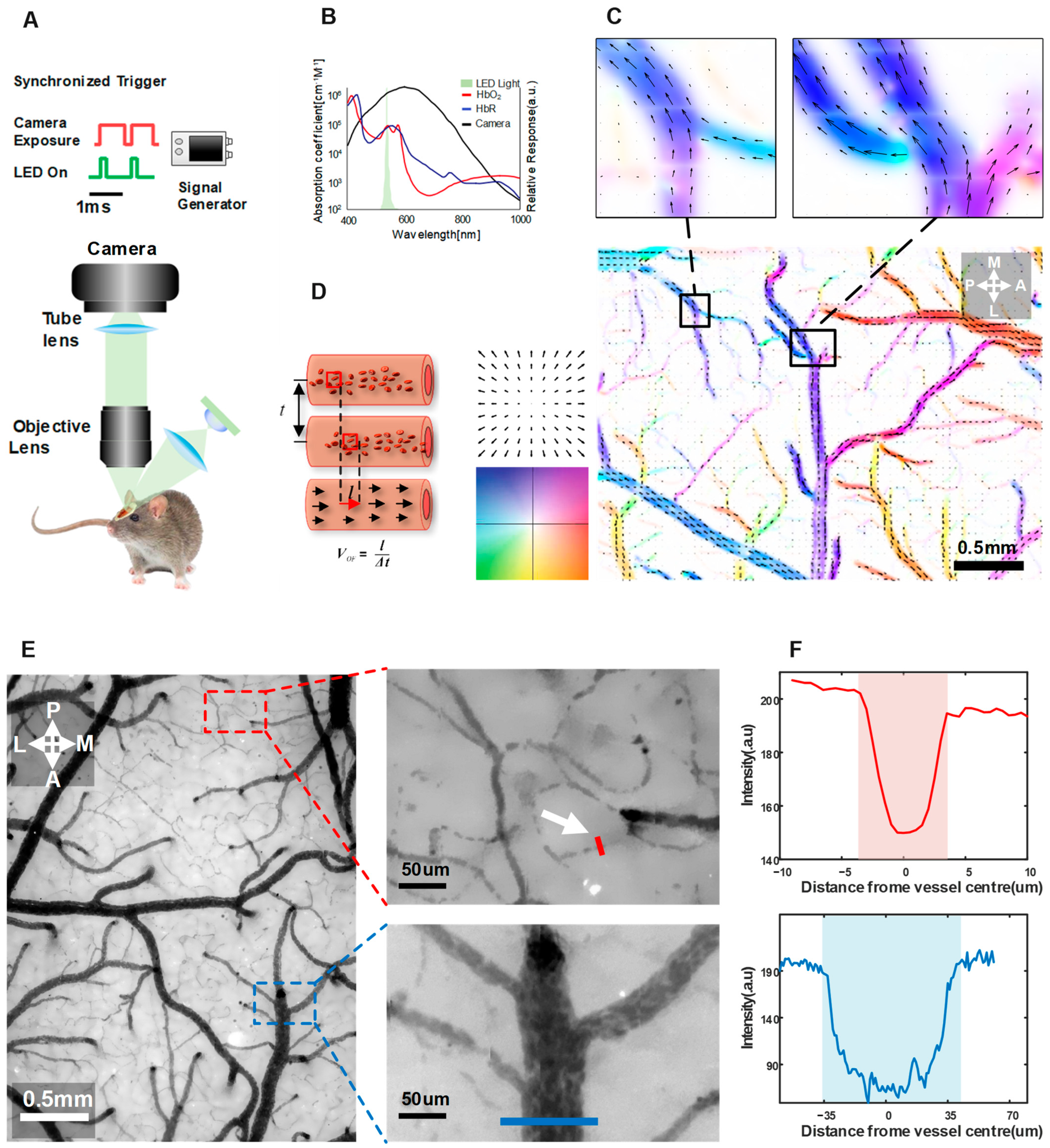
Disclaimer/Publisher’s Note: The statements, opinions and data contained in all publications are solely those of the individual author(s) and contributor(s) and not of MDPI and/or the editor(s). MDPI and/or the editor(s) disclaim responsibility for any injury to people or property resulting from any ideas, methods, instructions or products referred to in the content. |
© 2023 by the authors. Licensee MDPI, Basel, Switzerland. This article is an open access article distributed under the terms and conditions of the Creative Commons Attribution (CC BY) license (https://creativecommons.org/licenses/by/4.0/).
Share and Cite
Meng, L.; Huang, M.; Feng, S.; Wang, Y.; Lu, J.; Li, P. Optical Flow-Based Full-Field Quantitative Blood-Flow Velocimetry Using Temporal Direction Filtering and Peak Interpolation. Int. J. Mol. Sci. 2023, 24, 12048. https://doi.org/10.3390/ijms241512048
Meng L, Huang M, Feng S, Wang Y, Lu J, Li P. Optical Flow-Based Full-Field Quantitative Blood-Flow Velocimetry Using Temporal Direction Filtering and Peak Interpolation. International Journal of Molecular Sciences. 2023; 24(15):12048. https://doi.org/10.3390/ijms241512048
Chicago/Turabian StyleMeng, Liangwei, Mange Huang, Shijie Feng, Yiqian Wang, Jinling Lu, and Pengcheng Li. 2023. "Optical Flow-Based Full-Field Quantitative Blood-Flow Velocimetry Using Temporal Direction Filtering and Peak Interpolation" International Journal of Molecular Sciences 24, no. 15: 12048. https://doi.org/10.3390/ijms241512048
APA StyleMeng, L., Huang, M., Feng, S., Wang, Y., Lu, J., & Li, P. (2023). Optical Flow-Based Full-Field Quantitative Blood-Flow Velocimetry Using Temporal Direction Filtering and Peak Interpolation. International Journal of Molecular Sciences, 24(15), 12048. https://doi.org/10.3390/ijms241512048





